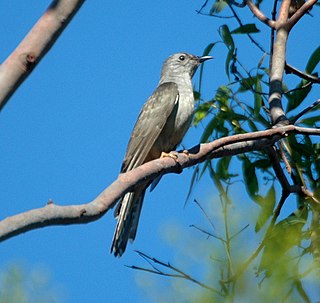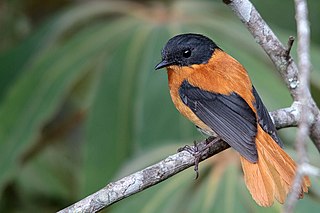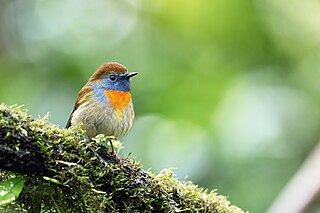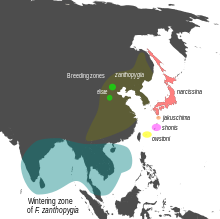
The Siberian stonechat or Asian stonechat is a recently validated species of the Old World flycatcher family (Muscicapidae). Like the other thrush-like flycatchers, it was often placed in the Turdidae in the past. It breeds in the East Palearctic including in easternmost Europe and winters in the Old World tropics.

The European pied flycatcher is a small passerine bird in the Old World flycatcher family. One of the four species of Western Palearctic black-and-white flycatchers, it hybridizes to a limited extent with the collared flycatcher. It breeds in most of Europe and across the Western Palearctic. It is migratory, wintering mainly in tropical Africa. It usually builds its nests in holes on oak trees. This species practices polygyny, usually bigamy, with the male travelling large distances to acquire a second mate. The male will mate with the secondary female and then return to the primary female in order to help with aspects of child rearing, such as feeding.

The collared flycatcher is a small passerine bird in the Old World flycatcher family, one of the four species of Western Palearctic black-and-white flycatchers. It breeds in southeast Europe and Eastern France to the Balkan Peninsula and Ukraine and is migratory, wintering in sub Sahara Africa. It is a rare vagrant in western Europe.

The red-breasted flycatcher is a small passerine bird in the Old World flycatcher family. It breeds in eastern Europe and across Central Asia and is migratory, wintering in south Asia. The bird is a regular passage migrant in western Europe, whereas the collared flycatcher which breeds further east is rare. This is because of the different migration direction. The Asian species Ficedula albicilla, previously considered a subspecies of the red-breasted flycatcher, has the red throat surrounded by grey and a different song. It is usually now separated as the taiga flycatcher.

The blue rock thrush is a species of chat. This thrush-like Old World flycatcher was formerly placed in the family Turdidae. It breeds in southern Europe, northwest Africa, and from Central Asia to northern China and Malaysia. The blue rock thrush is the official national bird of Malta and was shown on the Lm 1 coins that were part of the country's former currency.

The olive-sided flycatcher is a small to medium sized passerine bird in the family Tyrannidae, the Tyrant flycatcher family. It is a migratory species that travels from South to North America to breed during the summer. It is a very agile flyer and mainly consumes flying insects on flight. Since 2016, this species has been assessed as being near-threatened globally (IUCN) and threatened in Canada (SRA) due to its declining populations.

The Kashmir flycatcher is a small passerine bird in the flycatcher family Muscicapidae. It breeds in the Northwest Himalayas and winters in southern India and Sri Lanka. It was formerly considered to be a subspecies of the red-breasted flycatcher, Ficedula parva, which is its closest living relative. Males are distinctive in having a blackish border to the reddish throat while the females can easily be confused with those of F. parva.

The semicollared flycatcher is a small passerine bird in the Old World flycatcher family, one of the four species of Western Palearctic black-and-white flycatchers. It breeds in montane forests of the southeastern corner of Europe to Northwest Iran. It is migratory, wintering in Central and Eastern Africa. It is a rare vagrant in western Europe. Tracking studies using geolocators have revealed that weather conditions during spring migration can have a large impact on the timing of Semicollared flycatcher migration and survival of adult birds.
The green-backed flycatcher is a bird in the family Muscicapidae, which contains the Old World flycatchers. It was long considered to a subspecies of the narcissus flycatcher, but morphological and acoustical differences between the two indicate they are instead separate species. It breeds in northeastern China and winters in southeast Asia.

Cuculus saturatus, better well known as the Himalayan cuckoo or Oriental cuckoo, is a brooding parasitic bird that is part of the Cuculidae family. The species breeds from the Himalayas eastward to southern China and Taiwan. It migrates to southeast Asia and the Greater Sunda Islands for the winter.

The russet sparrow, also called the cinnamon or cinnamon tree sparrow, is a passerine bird of the sparrow family Passeridae. A chunky little seed-eating bird with a thick bill, it has a body length of 14 to 15 cm (5.5–5.9 in). Its plumage is mainly warm rufous above and grey below. It exhibits sexual dimorphism, with the plumage of both sexes patterned similarly to that of the corresponding sex of house sparrow. Its vocalisations are sweet and musical chirps, which when strung together form a song.

The Sahul brush cuckoo, formerly known as the brush cuckoo, is a member of the cuckoo family. It is native to Malesia, New Guinea, the Solomon Islands and northern and eastern Australia. It is a grey-brown bird with a buff breast. Its call is a familiar sound of the Australian and Indonesian bush.

The Japanese sparrowhawk is a bird of prey in the family Accipitridae which also includes many other diurnal raptors such as eagles, buzzards and harriers. It was formerly placed in the genus Accipiter. The bird is known by many alternative names such as the Japanese lesser, Asiatic, or Eastern sparrowhawk. This species is a small raptor with broader and rounder wings and a shorter tail. Its total length measures 23–30 centimetres (9.1–11.8 in). It has a dark back and whitish underside with brown-grey barring and red-brown colouring on the sides in males, and with heavier brown barring on the abdomen in females. Both sexes have a stripe across the throat, but its more obvious in the female. Is it typically identified by its appearance, but occasionally produces a chattering kiki-kik-kik... sound. This species generally breeds in parts of Russia, Korea, Japan, and China. There are three subspecies of Japanese sparrowhawk that differ by distribution and appearance. The species is globally listed as least concern, although it is listed as endangered in Japan and protected in China.

The yellow-rumped flycatcher, also known as Korean flycatcher or tricolor flycatcher, is a species of flycatcher found in eastern Asia. A distinctive species with almost no look-alike other than the narcissus flycatcher. It breeds in eastern Asia including parts of Mongolia, Transbaikal, southern China, Korea and western Japan. They winter in parts of the Malay Peninsula and South Asia.

The black-and-orange flycatcher or black-and-rufous flycatcher is a species of flycatcher endemic to the central and southern Western Ghats, the Nilgiris and Palni hill ranges in southern India. It is unique among the Ficedula flycatchers in having rufous coloration on its back and prior to molecular studies was suggested to be related to the chats and thrushes.

The black paradise flycatcher, also known as the Japanese paradise flycatcher, is a medium-sized passerine bird native to southeastern Asia. It is a glossy black, chestnut and white bird, slightly smaller than either the Amur paradise flycatcher or Blyth's paradise flycatcher, but similar in appearance. Males have exceptionally long tails. Females are generally duller in appearance and have shorter tails.

The flammulated flycatcher is a species of bird in the family Tyrannidae. It was formerly placed in the monotypic genus Deltarhynchus but was moved to the genus Ramphotrigon based on genetic analysis. It is endemic to the dry deciduous forest, arid thorn forest, and scrubby woodland of Mexico’s Pacific coast. The flycatcher is an olive to gray-brown bird with a streaked, pale gray chest, white throat, black bill, dark gray feet, and dark brown wings. It is a skulking bird that typically remains hidden in the underbrush. It feeds by gleaning insects off of leaves and twigs that it spots from an exposed perch. The female lays approximately three eggs in a nest made in a shallow tree cavity.

The rufous-gorgeted flycatcher is a species of bird in the family Muscicapidae.

The olive-striped flycatcher is a species of bird in the family Tyrannidae, the tyrant flycatchers. It is found in Bolivia, Colombia, Ecuador, Panama, Peru, Trinidad, and Venezuela.





















